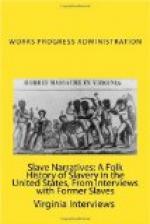“The little boys drove up the cows, slopped the hogs, got wood and pine for light, go to the spring and get water. After a boy was twelve then he let him work in the fields. My main job was hitching the horse to the buggy for old Miss Stevenson, and put the saddle on old master’s saddle horse.
“I was very small but when the first railroad come through old master took us to see the train. I guess it was about forty or fifty miles because it took us around four days to make the round trip. The trains were not like they are now. The engine was smaller and they burned wood and they had what they called a drum head and they didn’t run very fast, and could not carry many cars. It was a narrow gauge road and the rails were small and the road was dirt. It was not gravel and rocks like it is now. It was a great show to me and we all had something to talk about for a long time. People all around went to see it and we camped out one night going and coming and camped one night at the railroad so we could see the train the next day. A man kept putting wood in the furnace in order to keep a fire. Smoke come out of the drum head. The drum head was something like a big washpot or a big old hogshead barrel. An ox team was used for most all traveling. You did not see very many horses or mules.
“The white children taught us how to read and I went to school too.
“I went to church too. We did not have a church house; we used a brush arbor for service for a long time. In the winter we built a big fire in the middle and we sat all around the fire on small pine logs. Later they built a log church, so we had service in there for years.
“We did not live near a school, so old mistress and the children taught us how to read and write and count. I never went to school in my life and I bet you, can’t none of these children that rub their heads on college walls beat me reading and counting. You call one and ask them to divide ninety-nine cows and one bob-tailed bull by two, and they can’t answer it to save their lives without a pencil and paper and two hours’ figuring when it’s nothing to say but fifty.
“Wasn’t no cook stoves and heaters until about 1890 or 1900. If there was I did not know about them. They cooked on fireplace and fire out in the yard on what they called oven and we had plenty of plain grub. We stole eggs from the big house because we never got any eggs.
“The custom of marrying was just pack up and go on and live with who you wanted to; that is the Negroes did—I don’t know how the white people married. This lawful marrying came from the law since man made law.
“When anybody died everybody stopped working and moaned and prayed until after the burying.
“I can say there is as much difference between now and sixty years ago as it is in day and night.”
Interviewer: S. S. Taylor
Person interviewed: Henry Banner
County
Hospital
Little
Rock, Ark.
Age: ?




